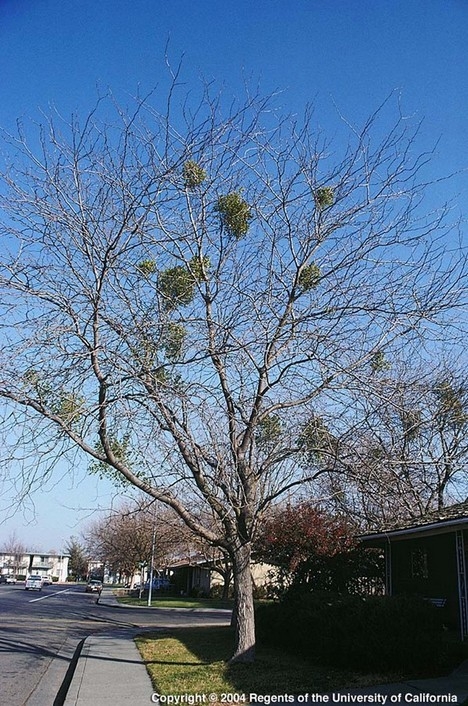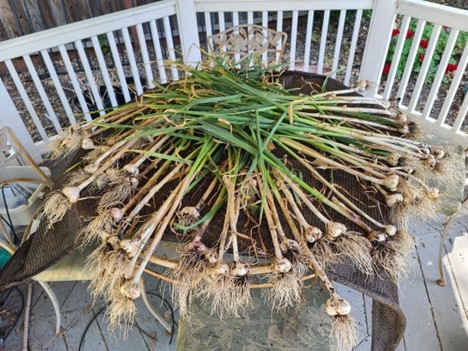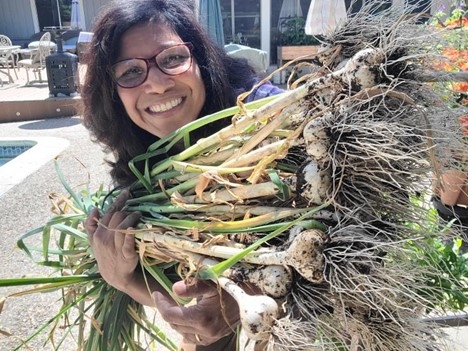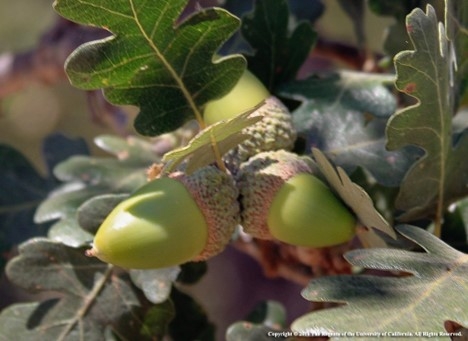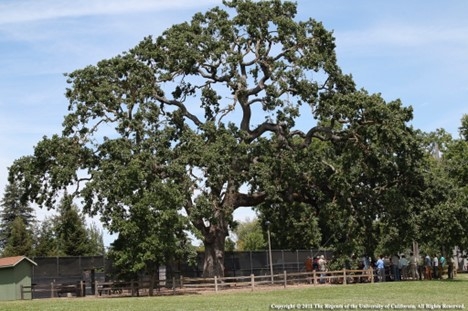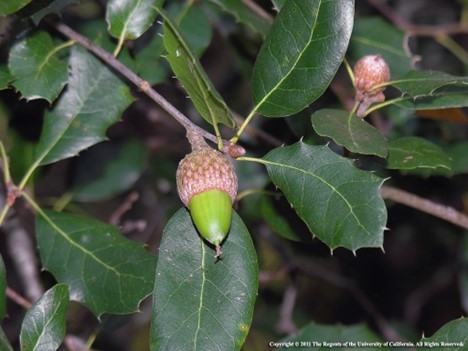- Author: Help Desk Team
Note: This was originally published in the Contra Costa Times.
Q: I have a lot of mistletoe in my street tree, which is some sort of ash, I think. Is it a problem and if so, how do I get rid of it?
A: Broadleaf mistletoe is an evergreen parasitic plant that grows on a number of landscape trees in California and can be readily observed on deciduous trees once the leaves have fallen. Modesto ash is especially susceptible to mistletoe infestations. As a parasite it absorbs both water and mineral nutrients from its host trees. Healthy trees can tolerate a few branch infections, but individual branches may be weakened or sometimes killed. Heavily infested trees may be reduced in vigor, stunted, or even killed, especially if they are stressed by other problems such as drought or disease.
The Mistletoe Lifecycle:
Mistletoe is either female (produce berries) or male (produce only pollen). The berries of the female are small, sticky, and whitish. Birds feed on and digest the pulp of the berries and excrete the living seeds which stick to any tree branch on which they land. After the seed germinates, it grows through the bark and into the tree's water- conducting tissues where rootlike structures called haustoria develop. These haustoria gradually extend up and down within the branch as the mistletoe grows, and for that reason if you simply remove the visible portion of the mistletoe, it will often resprout.
Controlling Mistletoe:
The most effective way to control mistletoe and prevent its spread is to prune out infested tree branches. Remove branches at their point of origin on the main trunk or back to a large lateral branch and cut at least one foot below the point of mistletoe attachment. Mistletoe infecting the trunk or a main branch where it cannot be pruned may be controlled by cutting off the mistletoe flush with the limb or trunk. You must then wrap the area with a few layers of black polyethylene to exclude light. Use twine or tape to secure the plastic to the limb, but do not wrap it too tightly or the branch may be damaged. Broadleaf mistletoe requires light and will die within a couple of years without it. It may be necessary to repeat this treatment.
Harvesting for the Holidays:
Simply cutting the mistletoe out of an infested tree each winter, even without wrapping, is better than doing nothing at all. Even though the parasite will grow back, spread is reduced because broadleaf mistletoe must be several years old before it can bloom and produce seed. Time your pruning right and you will have plenty of mistletoe for the holidays.
For More Information:
For more information on mistletoe and its management, the University of California has a free publication located at: https://ipm.ucanr.edu/PMG/PESTNOTES/pn7437.html
Help Desk of the UC Master Gardeners of Contra Costa County (EDC)
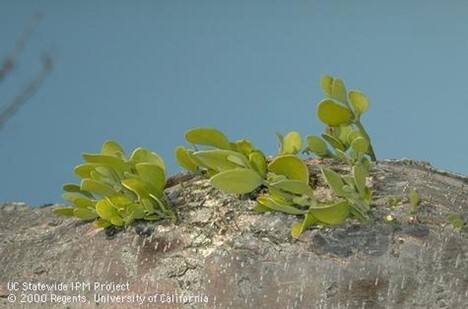
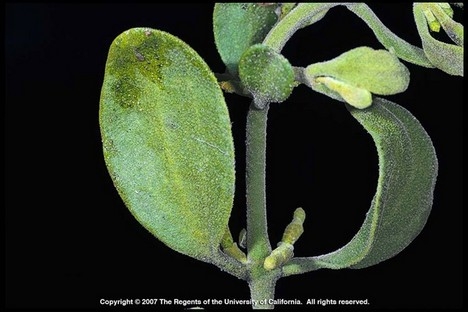
- Author: Help Desk Team
Garlic (Allium sativum) is loved and respected around the world as a symbol of protection and luck. It is thought to impart strength and endurance and is prized as a natural medicinal remedy with antibacterial, antiviral and antifungal properties. Impressive for such a humble vegetable.
Garlic is best planted in the fall for the largest bulb size at harvest. In USDA growing Zones 9 and 10, aim to get your garlic in the ground 6 weeks before the first frost. For much of Contra Costa County, this will be mid to late October. Bulb formation will begin in the spring as the daylight hours increase.
Refer to our previous blog post for an explanation of hardneck and softneck garlic and selecting seed garlic for the home garden. https://ccmg.ucanr.edu/our-blog/?blogpost=60828&blogasset=12496
Site selection
Find a convenient location with access to water and select a planting site which is level for consistent irrigation. Garlic takes 6 to 9 months to mature so the bed you select will not be available for another crop from October to June. Garlic does best in full sun (a minimum of 6 hours of sun a day). Clear all weeds from the bed and surrounding area. Weeds deprive the garlic of nutrients and water and can harbor many of the pests which are attracted to garlic.
Prepare the soil
Garlic does well in a wide range of soils, but the soil needs good drainage. Damp soil surfaces encourage snails, slugs, and root diseases. Much of our soil in Contra Costa County is heavy clay, so amendments are often added to give the clay soil a better structure. Adding organic matter such as compost, manure and leaf mold works well for this purpose. Dampen the soil before you work in the amendments to help the material to combine evenly. It is best not to overwork your soil. Gently mix the soil amendments into the top 2–4 inches of the soil and rake the surface smooth. Then water the plot wel to get the microorganisms working.
How to plant
Have a fertilizer on hand such as cottonseed meal that is in the range of 5-2-2. Gently break the cloves of garlic from the bulb. The largest cloves will grow the biggest bulbs. If you are planting different varieties, keep them separate and well-marked. Dig a trench about 3” deep, add the recommended amount of fertilizer and work it into the soil. Plant the garlic cloves 8” apart, giving them plenty of space for the bulb to form. Stand each clove up in the soil with the flat side down and the point up. Cover the garlic to about 1” above the tip of the garlic. Put in your plant stakes with the variety name at the end of each row. Water the bed to settle the soil and put a 3” layer of mulch over the bed. Less frequent, deep watering is the best practice for garlic to lessen the chance of bulb rot.
Fertilizing
Garlic is a heavy feeder. In the spring when there is 2–3” of new growth, pull back the mulch to warm the soil and apply the fertilizer you used at planting, repeating every 3–4 weeks until April. In May and June switch to a phosphorus fertilizer such as rock phosphate, bone meal, or bird guano to increase the bulb size.
In addition to the big 3 (N-P-K), garlic also needs these macronutrients: calcium, magnesium, and sulfur. There are also some micronutrients essential for garlic growth and development including iron, manganese, copper and zinc. Several applications of liquid kelp or kelp meal during the growing season can supply the additional nutritional needs.
Harvest time
In late spring, hardneck garlic will form scaping, a flower stalk which forms a whorl. Remove this stalk in the early growth stage. These are delicious when made into pesto or used in a quiche.
The first of June watch for the lower leaves of the garlic to begin to turn yellow. This is an indication that harvesting is close. For hardneck garlic look for 40-50% of the leaves to turn yellow. For softneck garlic look for 1/3 of the leaves to turn yellow. Dig up a few sample garlic bulbs and check to see if the bulbs have a uniform shape with good sized shoulders. If they are not ready, give them another week or two. When the bulbs have reached full size stop watering for a week to give the bulbs a chance to harden off a bit before harvest.
Using a garden fork (or a potato digging fork) gently lift the garlic bulbs out of the ground. Work the soil off the bulb and the roots, move the garlic to a well shaded area with good air circulation.
Curing
Lay the garlic out in a single layer. Make a second pass over the garlic, cutting the roots back by half and the stem to 9 inches in length. If air circulation is lacking, use an oscillating fan to keep the air moving for the first two weeks. Let the garlic cure for 3–4 weeks. At this time cut the roots to 1/4” and the stem to 1/2” and continue to cure for an additional 2–3 weeks. When there is NO green visible in the stem the garlic is ready for storage.
Storage
Garlic needs breathing room so wire-mesh baskets or mesh bags are the best containers. Low light, cool temperatures (35-55°) and moderate humidity (40-60%) is ideal for garlic storage. Garlic can be stored in the refrigerator but once it's removed from the cold it is very quick to sprout.
With some garden prep, meeting the nutritional needs of garlic, having patience for the long growing season, and careful curing, you can be richly rewarded with a bumper crop of garlic. You may well be the envy of your fellow gardeners, family, and friends.
IPM Garlic Pest and Disease Management
https://ipm.ucanr.edu/home-and-landscape/onions-and-garlic/index.html?src=307-pageViewHLS
Garlic Cultural Practices
https://ipm.ucanr.edu/home-and-landscape/onions-and-garlic/cultural-tips/index.html?src=307-pageViewHLS
Help Desk of the UC Master Gardeners of Contra Costa County (BHD)
- Author: Help Desk Team
Whether you fall into the camp of a little goes a long way or too much is never enough, I hope to convince you that growing garlic is worthy of your time and some space in the garden. Let's look at this amazing and ancient plant.
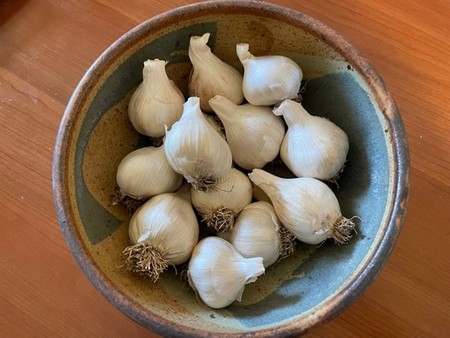
Historically garlic grew wild over much of Europe, Central Asia and the Far East. There are references to garlic going back as far as 5000 years ago. It is believed that softneck garlic was the first cultivated garlic. It has only been in the last 1000 years that the distinction was made between hardneck and softneck garlic.
Let's investigate the difference between hardneck and softneck garlic, as they vary in their structure, flavor, and growing requirements.
• Hardneck garlic is cold hardy and known for its robust, strong flavor. This garlic typically yields fewer cloves, with each clove being large and plump. Hardneck garlic has a central, hard stalk and produces garlic scapes, which are the flowering stem. These edible scapes are produced in late spring or early summer.
• Softneck garlic is better suited to growing in warmer climates. It has a milder, less pungent flavor profile. Softneck garlic bulbs have more cloves, but the cloves are smaller. Softneck garlic has no hard, central stalk and does not produce scapes, but if you want to braid your garlic, you need to grow softneck garlic. This is the grocery store type, available because it has a longer shelf life.
Planting garlic is easy but be aware when you put it in the ground you are dedicating that garden plot for 8–10 months. I like to use the rotation of putting garlic in the ground in mid-October which allows for harvest in June when the soil is warm enough to put peppers in the ground after the garlic is pulled out. Make sure you select a variety of garlic which is mature in under 240 days.
The reason for fall planting is that the lingering warmth of the soil allows the roots to get established and allows the bulbs to develop some leaf growth before colder weather begins. Garlic needs cold temperatures to stimulate root growth. Hardneck garlic requires 4–6 weeks of cold below 40–45° F. to develop a strong bulb. This chilling process is called vernalization. Softneck garlic is less demanding and does not need the extended chill hours. This makes softneck garlic a good choice where winter temperatures are mild.
Garlic will go dormant during the cooler months but will reawaken when the soil warms in the spring, giving it a jump start on the growing season. If you miss the October planting date, you can plant in February in our Contra Costa County growing zones, but your garlic bulbs will be small. Spring planting should be your last resort. In our clay soil, raised beds are a good choice, as garlic bulbs can rot in wet, clay soil.
It is recommended that you purchase “seed garlic” because it is grown for planting out and does not go into the grocery store pipeline. Seed garlic is bred to be pest and disease free. It will not have been treated with a sprouting inhibitor which may have been applied to grocery store garlic. I know gardeners who grow grocery store garlic successfully, but my personal choice is seed garlic, if for no other reason than the wonderful and diverse varieties available.
You will need to cover the garlic with a nice cushion of mulch during the colder months. Dry leaves or straw work well for this purpose. In the spring, when you see new growth on the garlic, pull back the mulch so the soil can begin to warm. When new growth appears, begin a schedule for fertilizing. Weeds are the enemy of garlic so weed early and often, but gently so you don't disturb the bulbs.
I hope you have the space and are willing to invest the time it takes to grow a bed of garlic. I think you will be richly rewarded.
For cultural information on watering, fertilizing, and harvesting, stay tuned for the next post.
Garlic: A Brief History (from the University of Missouri): https://ipm.missouri.edu/meg/2015/9/garlic-a-brief-history/
Help Desk of the UC Master Gardeners of Contra Costa County (BHD)
- Author: Help Desk Team
Note: This was originally published in the Contra Costa Times
Conquer weeds by understanding their life cycles
As a gardener in Contra Costa County, you know from observation that weeds have an immense capacity to produce seeds. In fact, the high reproductive output of weeds is astounding. Per plant, pigweed produces 117,400 seeds, mullein 223,200, lambsquarters 72,450, shepherd's purse 38,500, johnsongrass 80,000, curly dock 29,500, and wild mustard a mere 16,000 seeds.
Weed flowers can be small and inconspicuous, but, after flowering profusely over a period of several months, they produce a tremendous quantity of seeds. Black medic, kikuyugrass, and spotted catsear flower 5 to 7 months. Dandelions bloom 9 months out of the year and each flower produces thousands of wind-borne minutely barbed pappus-bearing seeds which can germinate year-round.
The sheer quantity of seeds ensures waves of seedlings. Yet, germination is discontinuous: it doesn't happen all at once. In gardens and in other disturbed areas, seeds are stored in the soil until shallow tillage brings them to the surface where conditions for germination are ideal.
Weed seeds persist in the soil below the germination zone and can be viable for a surprisingly long period of time. Mustard seeds thought to be 600 years old were excavated from a monastery garden in Denmark and 11 of them germinated. The longevity of field bindweed seeds is over 50 years. Lambsquarters seeds are viable for 20 to 50 years. Grass seeds tend to live an average of 3 to 10 years, whereas broadleaf weed seeds can be part of the soil seedbank for a much longer time
Life Cycle of Weeds:
Like other members of the plant kingdom, weeds are classified as annuals, biennials or perennials. The seeds of summer annuals germinate in the spring and mature plants generate seeds in summer and fall. Winter annuals sprout in the fall, live through the winter and produce seeds during the winter and spring. Biennial weeds spend their first year producing leaves before they flower and bear seed during their second and final year of life. Perennial weeds propagate by seeding but also vegetatively by means of creeping roots, rhizomes, taproots or bulbils. Weeds in their various stages of growth, flowering, seed production and dispersal are with us all year.
Weed Seed Dispersal:
Weed seed dispersal is varied and opportunistic. Though many mature weed seeds fall next to the parent plant, quantities of others are tumbled along or parachuted for miles by wind. Some burst out of capsules, landing 3 to 15 feet away. Others hitch a ride by attaching themselves to animal fur with burs or seed hooks. Many are digested by birds or livestock, transported by water or by the gardener's boots and tools. In their quest for territorial expansion, weeds use gardens as seed factory sites, as seed storage facilities and as launching pads for seed dispersal by gardeners.
Production of large quantities of seed, opportunistic seed dispersal, long- flowering periods, long seed viability, year-round seed production, and
discontinuous germination are successful strategies that weeds use to ensure their survival and expansion.
Managing Weed Seeds:
Weed seed management works best if you combine methods of control. Choose an irrigation system such as drip irrigation or microsprinklers so that only your plantings are watered. Be aware that cultivation brings weed seeds to the surface where they can germinate. Do not let weeds go to seed and replenish their weed seed reservoir in the soil. Reduce weed seed germination by eliminating their light source through use of a thick layer of mulch.
For More Information:
If you would like more information about identification of and controls for specific weeds, consult these University of California web sites:
https://wric.ucdavis.edu/
http://ipm.ucanr.edu/PMG/menu.weeds.html
http://ipm.ucanr.edu/PMG/PESTNOTES/pn7441.html
Help Desk of the UC Master Gardeners of Contra Costa County (CG)
- Author: Help Desk Team
Note: This was originally published in the Contra Costa Times.
Q: I know that acorns are the seeds of oak trees, but how do I plant them?
A: Oaks are an important part of the California landscape. If you are lucky enough to have oak trees on your property, or access to others' oak trees, you can collect the acorns and plant them. There are some simple things you can do to ensure a good start for your oaks.
Selecting the Site:
First of all, only plant a given oak species in areas where it naturally occurs or has grown in the past, and only use acorns from oaks growing in the same general environment as the planting site. Even within a species, there are genetic adaptations to different soils and climates. Use acorns from trees that grow as close to the planting site as possible.
Collecting Acorns:
Collect acorns in the early fall, when they are just starting to turn from green to brown and the first ones fall to the ground. Acorns collected from trees are generally healthier and more likely to germinate than those that have fallen to the ground. Pick them from the tree, twist off the caps (they should come off easily) and immediately put the acorns in the refrigerator to slow their metabolic activity.
If you collect them from the ground, discard any that are broken, cracked, very small, or lightweight, and soak them for a day in water, discarding any that float. Then dry them off and put them in plastic bags in the refrigerator.
Storing Acorns:
Although they can be planted right away, acorns that have been stored in the refrigerator for one month have higher germination rates than those planted right after collecting. Check them for mold, and if any mold develops, rinse it off, dry the acorns, and put them back in the refrigerator in plastic bags. Leaving part of the bag open at the end helps to reduce mold growth. If you see white tips emerging from the pointed end of the acorns during storage, it's best to plant them right away. That's the start of the root system emerging, and it can turn dark and mushy if left in storage.
Planting Your Acorns:
The best time to plant the acorns is from November after the first rain to early March. However, earlier is better to give them more time to grow before hot weather arrives.
Plant them in full sun. Keep the eventual height and canopy size of the tree in mind when you choose a location. Loose, well- drained soil is best, and the area should be fairly free of weeds.
Plant the acorns one half to one inch below the soil surface. Dig a hole several inches deep then partially backfill it. Place the acorns on their sides in the holes and cover with soil. If they've already started to germinate, plant them root down, being careful not to break the root tip. If you have a lot of nearby pocket gopher or ground squirrel activity, you can give the acorns a better chance by planting them two inches deep, but don't go any deeper than that or the acorns will rot.
You can also start the acorns in containers and plant the seedlings later. For information about this method, see the UC web page, How to Grow California Oaks (https://oaks.cnr.berkeley.edu/how-to-grow-california-oaks/).
Caring for Your Trees:
Weeds, especially grasses, will out-compete oak seedlings for sun, water and nutrients, so keep a two-to-three-foot radius around each seedling clear of weeds. Remove weeds by hand or with a hoe. Mulch suppresses weed growth and helps conserve soil moisture. Bark chips, straw, compost, or paper can be used.
Oaks develop vigorous and large root systems—that's how they survive drought. If the rains are very light, one or two deep supplemental waterings in late winter and early spring can help the seedlings survive through their first summer.
Acorns and oak seedlings are an important food source for rabbits, insects, mice and other animals. A variety of protective devices can be used to prevent their damage.
With some encouragement and protection, your seedlings will be well on their way to becoming oak trees. You may not live to see them mature, but future generations will enjoy these magnificent trees.
Help Desk of the UC Master Gardeners of Contra Costa County (EM)


